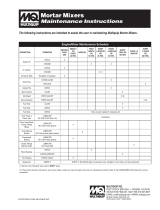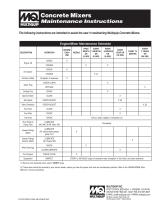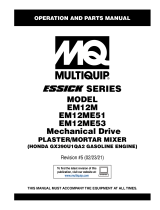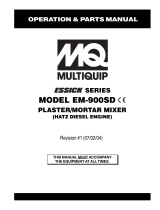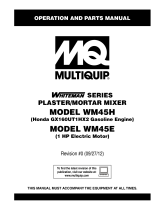Page is loading ...

OPERATION MANUAL
THIS MANUAL MUST ACCOMPANY THE EQUIPMENT AT ALL TIMES.
To find the latest revision of this
publication, visit our website at:
www.multiquip.com
SERIES
MODELS
PRO12/PRO12E51
PRO12E53/PRO12E53-460V
HYDRAULIC PLASTER/MORTAR MIXERS
(HONDA GX390RT2-QNB2 GASOLINE ENGINE/
TECO WESTINGHOUSE 5HP ELECTRIC MOTOR)
Revision #4 (10/30/19)
To find the latest revision of this publication or
associated parts manual, visit our website at:
www.multiquip.com

PAGE 2 — PRO12 HYDRAULIC MIXER • OPERATION MANUAL — REV. #4 (10/30/19)
PROPOSITION 65 WARNING

PRO12 HYDRAULIC MIXER • OPERATION MANUAL — REV. #4 (10/30/19) — PAGE 3
SILICOSIS/RESPIRATORY WARNINGS
Grinding/cutting/drilling of masonry, concrete, metal and
other materials with silica in their composition may give
off dust or mists containing crystalline silica. Silica is a
basic component of sand, quartz, brick clay, granite and
numerous other minerals and rocks. Repeated and/or
substantial inhalation of airborne crystalline silica can
cause serious or fatal respiratory diseases, including
silicosis.In addition, California and some other
authorities have listed respirable crystalline silica as a
substance known to cause cancer. When cutting such
materials, always follow the respiratory precautions
mentioned above.
WARNING
Grinding/cutting/drilling of masonry, concrete, metal and
other materials can generate dust, mists and fumes
containing chemicals known to cause serious or fatal
injury or illness, such as respiratory disease, cancer,
birth defects or other reproductive harm. If you are
unfamiliar with the risks associated with the particular
process and/or material being cut or the composition of
the tool being used, review the material safety data
sheet and/or consult your employer, the material
manufacturer/supplier, governmental agencies such as
OSHA and NIOSH and other sources on hazardous
materials. California and some other authorities, for
instance, have published lists of substances known to
cause cancer, reproductive toxicity,or other harmful
effects.
Control dust, mist and fumes at the source where
possible. In this regard use good work practices and
follow the recommendations of the manufacturers or
suppliers, OSHA/NIOSH, and occupational and trade
associations.Water should be used for dust
suppression when wet cutting is feasible. When the
hazards from inhalation of dust, mists and fumes cannot
be eliminated, the operator and any bystanders should
always wear a respirator approved by NIOSH/MSHA for
the materials being used.
WARNING
SILICOSIS WARNING RESPIRATORY HAZARDS

PAGE 4 — PRO12 HYDRAULIC MIXER • OPERATION MANUAL — REV. #4 (10/30/19)
TABLE OF CONTENTS
PRO12 Hydraulic Mixer
Proposition 65 Warning ........................................... 2
Silicosis/Respiratory Warnings ................................ 3
Table of Contents ..................................................... 4
Safety Information ............................................. 6–10
Specifications ........................................................ 11
Dimensions ............................................................ 12
General Information ............................................... 13
Components (Mixer) ........................................ 14–15
Components (Engine) ............................................ 16
Electric Motor ........................................................ 17
Inspection ........................................................ 18–20
Paddle Blade Adjustment ...................................... 21
Operation ......................................................... 22–26
Maintenance .................................................... 27–29
Troubleshooting (Engine) ................................. 31–32
Troubleshooting (Motor) ......................................... 33
Troubleshooting (Mixer) ......................................... 34
Hydraulic Hose Connections ................................. 35
Hydraulic System Locator ...................................... 36
Hydraulic System Diagram .................................... 37
Electric Motor (Single Phase) Wiring Diagram ...... 38
Electric Motor (Three Phase) Wiring Diagram ....... 39
NOTICE
Specifications and part numbers are subject to change
without notice.

PRO12 HYDRAULIC MIXER • OPERATION MANUAL — REV. #4 (10/30/19) — PAGE 5
NOTES

PAGE 6 — PRO12 HYDRAULIC MIXER • OPERATION MANUAL — REV. #4 (10/30/19)
SAFETY INFORMATION
Do not operate or service the equipment before reading
the entire manual. Safety precautions should be followed
at all times when operating this equipment.
Failure to read and understand the safety
messages and operating instructions could
result in injury to yourself and others.
SAFETY MESSAGES
The four safety messages shown below will inform you
about potential hazards that could injure you or others. The
safety messages specifi cally address the level of exposure
to the operator and are preceded by one of four words:
DANGER, WARNING, CAUTION
or NOTICE.
SAFETY SYMBOLS
DANGER
Indicates a hazardous situation which, if not avoided,
WILL result in DEATH or SERIOUS INJURY.
WARNING
Indicates a hazardous situation which, if not avoided,
COULD result in DEATH or SERIOUS INJURY.
CAUTION
Indicates a hazardous situation which, if not avoided,
COULD result in MINOR or MODERATE INJURY.
NOTICE
Addresses practices not related to personal injury.
Potential hazards associated with the operation of this
equipment will be referenced with hazard symbols which
may appear throughout this manual in conjunction with
safety messages.
Lethal exhaust gas hazards
Explosive fuel hazards
Burn hazards
Rotating parts hazards
Symbol Safety Hazard

PRO12 HYDRAULIC MIXER • OPERATION MANUAL — REV. #4 (10/30/19) — PAGE 7
SAFETY INFORMATION
GENERAL SAFETY
CAUTION
NEVER operate this equipment without proper protective
clothing, shatterproof glasses, respiratory protection,
hearing protection, steel-toed boots and other protective
devices required by the job or city and state regulations.
Avoid wearing jewelry or loose fi tting clothes that may
snag on the controls or moving parts as this can cause
serious injury.
NEVER operate this equipment when not
feeling well due to fatigue, illness or when
under medication.
NEVER operate this equipment under the
infl uence of drugs or alcohol.
ALWAYS clear the work area of any debris, tools, etc.
that would constitute a hazard while the equipment is
in operation.
ALWAYS check the equipment for loosened threads or
bolts before starting.
DO NOT use the equipment for any purpose other than
its intended purposes or applications.
NOTICE
This equipment should only be operated by trained and
qualifi ed personnel 18 years of age and older.
Whenever necessary, replace nameplate, operation and
safety decals when they become diffi cult read.
Manufacturer does not assume responsibility for any
accident due to equipment modifi cations. Unauthorized
equipment modifi cation will void all warranties.
NEVER
use accessories or attachments that are not
recommended by Multiquip for this equipment. Damage
to the equipment and/or injury to user may result.
ALWAYS know the location of the nearest
fi re extinguisher.
ALWAYS know the location of the nearest
fi rst aid kit.
ALWAYS know the location of the nearest phone or
keep
a phone on the job site.
Also, know the phone numbers
of the nearest ambulance, doctor and
fi re department.
This information will be invaluable in the case of an
emergency.

PAGE 8 — PRO12 HYDRAULIC MIXER • OPERATION MANUAL — REV. #4 (10/30/19)
SAFETY INFORMATION
MIXER SAFETY
DANGER
NEVER operate the equipment in an explosive
atmosphere or near combustible materials. An
explosion or fi re could result causing severe
bodily harm or even death.
DO NOT mix fl ammable or explosive substances.
WARNING
NEVER place your hands inside the drum
while starting or operating this equipment.
NEVER disconnect any emergency
or safety devices. These devices are
intended for operator safety. Disconnection of these
devices can cause severe injury, bodily harm or even
death. Disconnection of any of these devices will void
all warranties.
Before operating mixer, ensure that safety grate is in
position and correctly fi tted.
CAUTION
NEVER lubricate components or attempt service on a
running machine.
NOTICE
ALWAYS keep the machine in proper running condition.
ALWAYS ensure mixer is on level ground before mixing.
Fix damage to machine and replace any broken parts
immediately.
DO NOT tip mixer onto drum mouth when the drum is
rotating.
Ensure the drum is rotating while fi lling and emptying
the drum.
ALWAYS store equipment properly when it is not being
used. Equipment should be stored in a clean, dry location
out of the reach of children and unauthorized personnel.
ALWAYS deploy stabilizer jack stands prior to use.
ENGINE SAFETY (GASOLINE MODELS ONLY)
DANGER
Engine fuel exhaust gases contain poisonous carbon
monoxide. This gas is colorless and odorless, and can
cause death if inhaled.
The engine of this equipment requires an adequate
free fl ow of cooling air. NEVER
operate this equipment
in any enclosed or narrow
area where free fl ow of the
air is restricted. If the air
fl ow is restricted it will cause
injury to people and property
and serious damage to the
equipment or engine.
WARNING
DO NOT
place hands or fingers inside engine
compartment when engine is running.
NEVER
operate the engine with heat shields or
guards removed.
Keep fi ngers, hands hair and clothing away
from all moving parts to prevent injury.
DO NOT remove the engine oil drain plug
while the engine is hot. Hot oil will gush out of the oil
tank and severely scald any persons in the general area
of the mixer.
CAUTION
NEVER touch the hot exhaust manifold,
muffl er or cylinder. Allow these parts to cool
before servicing equipment.
Make certain the operator knows how to and is capable
of turning the engine OFF in case of an emergency.
NOTICE
NEVER
run engine without an air fi lter or with a dirty air
fi lter. Severe engine damage may occur. Service air fi lter
frequently to prevent engine malfunction.
NEVER tamper with the factory settings
of the engine or engine governor. Damage
to the engine or equipment can result
if operating in speed ranges above the
maximum allowable.

PRO12 HYDRAULIC MIXER • OPERATION MANUAL — REV. #4 (10/30/19) — PAGE 9
SAFETY INFORMATION
FUEL SAFETY (GASOLINE MODELS ONLY)
DANGER
DO NOT add fuel to equipment if it is placed inside truck
bed with plastic liner. Possibility exists of explosion or
fi re due to static electricity.
DO NOT start the engine near spilled fuel or combustible
fl uids. Fuel is extremely fl ammable and its vapors can
cause an explosion if ignited.
ALWAYS refuel in a well-ventilated area, away from
sparks and open fl ames.
ALWAYS use extreme caution when working with
fl ammable liquids.
DO NOT fi ll the fuel tank while the engine is running
or hot.
DO NOT overfi ll tank, since spilled fuel could ignite if it
comes into contact with hot engine parts or sparks from
the ignition system.
Store fuel in appropriate containers, in well-ventilated
areas and away from sparks and fl ames.
NEVER use fuel as a cleaning agent.
DO NOT smoke around or near the
equipment. Fire or explosion could result
from fuel vapors or if fuel is spilled on a
hot engine.
FUEL
FUEL
GENERATOR SAFETY
If using a generator to power mixer, refer
to applicable generator manual safety
information section.
ELECTRIC MOTOR SAFETY (ELECTRIC MODELS
ONLY)
NOTICE
Operate electric motor only at the specifi ed voltage
indicated on the nameplate.
DO NOT spray water onto electric motor.
ALWAYS
disconnect AC power plug from power source
before moving mixer.
ALWAYS make sure the ON/OFF switch
on the electric motor is in the OFF position
when not in use and before inserting the
mixer’s power plug into an AC receptacle.
Power Cord/Cable Safety
DANGER
NEVER let power cords or cables lay in water.
NEVER use damaged or worn
cables or cords when
connecting equipment to generator. Inspect for cuts in
the insulation.
NEVER grab or touch a live power
cord or cable with wet hands. The
possibility exists of electrical shock,
electrocution or death.
Make sure power cables are securely connected.
Incorrect connections may cause electrical shock and
damage to the mixer.
CAUTION
Ensure that cables and cords will not be tripped over or
trapped underneath the mixer.
NOTICE
ALWAYS
make certain that proper power or extension
cord has been selected for the job.

PAGE 10 — PRO12 HYDRAULIC MIXER • OPERATION MANUAL — REV. #4 (10/30/19)
SAFETY INFORMATION
TRANSPORTING SAFETY
CAUTION
NEVER allow any person or animal to stand underneath
the equipment while lifting.
NOTICE
ALWAYS make sure forklift forks are inserted into pockets
(if applicable) as far as possible when lifting the mixer.
ALWAYS shutdown engine before transporting.
NEVER lift the equipment while the engine is running.
Tighten fuel tank cap securely and close fuel cock to
prevent fuel from spilling.
DO NOT lift machine to unnecessary heights.
ALWAYS tie down equipment during transport by
securing the equipment with rope.
NEVER tip the engine to extreme angles during lifting as
it may cause oil to gravitate into the cylinder head, making
the engine start diffi cult.
ENVIRONMENTAL SAFETY/
DECOMMISSIONING
NOTICE
Decommissioning is a controlled process used to safely
retire a piece of equipment that is no longer serviceable.
If the equipment poses an unacceptable and unrepairable
safety risk due to wear or damage or is no longer cost
effective to maintain (beyond life-cycle reliability) and is to
be decommissioned (demolition and dismantlement),be
sure to follow rules below.
DO NOT pour waste or oil directly onto the ground, down
a drain or into any water source.
Contact your country's Department of
Public Works or recycling agency in your
area and arrange for proper disposal of
any electrical components, waste or oil
associated with this equipment.
When the life cycle of this equipment is over, remove
battery if equipped and bring to appropriate facility for
lead reclamation. Use safety precautions when handling
batteries that contain sulfuric acid.
When the life cycle of this equipment is over, it is
recommended that the mixer frame and all other metal
parts be sent to a recycling center.
Metal recycling involves the collection of metal from
discarded products and its transformation into raw
materials to use in manufacturing a new product.
Recyclers and manufacturers alike promote the process
of recycling metal. Using a metal recycling center
promotes energy cost savings.
EMISSIONS INFORMATION
NOTICE
The gasoline engine used in this equipment has been
designed to reduce harmful levels of carbon monoxide
(CO), hydrocarbons (HC) and nitrogen oxides (NOx)
contained in gasoline exhaust emissions.
This engine has been certifi ed to meet US EPA Evaporative
emissions requirements in the installed confi guration.
Attempting to modify or make adjustments to the engine
emmission system by unauthorized personnel without
proper training could damage the equipment or create an
unsafe condition.
Additionally, modifying the fuel system may adversely affect
evaporative emissions, resulting in fi nes or other penalties.
Emission Control Label
The emission control label is an integral part of the emission
system and is strictly controlled by regulation(s).
The label must remain with the engine for its entire life.
If a replacement emission label is needed, please contact
your authorized engine distributor.

PRO12 HYDRAULIC MIXER • OPERATION MANUAL — REV. #4 (10/30/19) — PAGE 11
SPECIFICATIONS
Table 1. Mixer Specifications
Capacity 12.0 cu. ft. (340 liters)
Bag Capacity 3 to 4 bags
Operating Weight 1,580 lb. (716.67 kg)
Maximum Aggregate Size 1 in. (25.4 mm)
Adjustable Drum Discharge Height Up to 42.5 in. (1,079.5 mm)
Drive System Hydraulic
Dump Action Hydraulic
Table 2. Engine Specifications
Model Honda GX390RT2-QNB2
Type Air-cooled, 4-stroke, horizontal-shaft, gasoline engine
Bore × Stroke 3.46 in. × 2.51 in. (88 mm × 64 mm)
Displacement 23.7 cu. in. (389 cc)
Max. Output 11.7 hp @ 3,600 rpm
Continuous Output 9.0 hp @ 3,600 rpm
Fuel Tank Capacity Approx. 5.0 U.S. gallons (18.9 liters)
Fuel Unleaded gasoline
Lube Oil Capacity 1.16 qt. (1.1 liters)
Speed Control Method Centrifugal fly-weight type
Starting Method Electric start
Table 3. Electric Motor Specifications
Model Teco Westinghouse Model 3414 Teco Westinghouse Model 3481
Enclosure TEFC TEFC
Horsepower 5 5
Input Voltage (VAC) 230 230/460
Phase 1 3
Frequency (Hz) 60 60
Max Output @ RPM 5 hp @ 1,745 5 hp @ 1,725
Full Load Amps 30 12.24/6.12
Weight 103 lb. (46.7 kg) 103 lb. (46.7 kg)
Dimensions (L × W × H)
18.03 × 8.8 × 10.5 in.
(458 × 223.5 × 266.7 mm)
15.79 × 8.8 × 10.5 in
(401 × 223.5 × 266.7 mm)

PAGE 12 — PRO12 HYDRAULIC MIXER • OPERATION MANUAL — REV. #4 (10/30/19)
DIMENSIONS
Table 4. Mixer Dimensions
Reference Designator Dimension in. (mm.)
A (Length) 73.5 (1,917.7)
B (Width) 35.0 (889)
C (Height) 45.0 (1,143)
Figure 1. Mixer Dimensions
A B
C

PRO12 HYDRAULIC MIXER • OPERATION MANUAL — REV. #4 (10/30/19) — PAGE 13
GENERAL INFORMATION
APPLICATION
The Multiquip PRO12 hydraulic mixer (with drum capacity of
12.0 cubic feet/340 liters) is shipped completely assembled,
factory tested, and ready for use. This mixer has a batch
capacity of 3-1/2 to 4-1/2 bags.
POWER PLANTS
This hydraulic mixer is powered by either an 11.7 hp Honda
GX390RT2-QNB2 air-cooled, 4-stroke, gasoline engine
(reference Table 2), or a 5 hp electric motor. Reference
Table 3 for more detailed information regarding the electric
motor.
ENGINE MAINTENANCE
For basic engine maintenance, refer to the engine
maintenance section in this manual. For more detailed
engine maintenance, refer to the Honda Engine Owner’s
Manual furnished with the engine.
ELECTRICAL
If the mixer is equipped with an electric motor, make sure
that the power being supplied to the motor corresponds to
the voltage rating label on the motor. Supplying the wrong
voltage to the electric motor will cause severe electrical
damage to the motor. Reference Table 3 for electric motor
specifications.
Always make sure the ON/OFF switch on the electric motor
is in the OFF position before applying power.
WARNING
This mixer is intended only for the mixing of plaster
and mortar. The mixer must be used for its intended
purpose and is not suitable for mixing flammable or
explosive substances. The mixer must not be used
in an explosive atmosphere.
EXTENSION CABLES
The extension cable should be a 3-wire configuration that
includes a ground wire that conforms to UL code. The wire
cross section must be a minimum of 2.5 mm². Choose an
extension cord of adequate current-carrying capacity as
referenced in Table 7. Remember, cable distance affects
the current-voltage capacity of the extension cable.
Ensure that the extension cable is carefully laid out avoiding
wet areas, sharp edges, and locations where vehicles
might run over it. Avoid allowing the extension cable to be
trapped underneath the mixer.
Unroll the extension cable fully or it will overheat and could
catch fire. Make sure that all extension cable connections
are dry and safe. Replace any defective or badly worn
extension cables immediately.
HARDWARE
Check all hardware on the mixer before starting. Periodically
inspect all hardware. Loose hardware can contribute to
early component failure and poor performance. Keep all
mixer hardware components tight.

PAGE 14 — PRO12 HYDRAULIC MIXER • OPERATION MANUAL — REV. #4 (10/30/19)
COMPONENTS (MIXER)
Figure 2. Mixer Components
6
6
3
4
11
12
13
14
8
10
9
19
22
1
2
5
7
15
16
17
18
19
10
20
20
21
3
12

PRO12 HYDRAULIC MIXER • OPERATION MANUAL — REV. #4 (10/30/19) — PAGE 15
1. Hydraulic Paddle Control Lever — 3-position lever.
Push inward for clockwise mixing rotation of blades.
Place in center position for no rotation (neutral/off).
2. Hydraulic Dump Lever — This lever is only provided
on mixers with hydraulic dump capability. Pull the lever
outward to activate the dump cylinder.
3. Latch — Use this latch to secure the engine
compartment enclosure.
4. Engine Cover — Lift this cover to gain access to the
engine or electric motor.
5. Hydraulic Oil Sight Gauge — This gauge indicates
the level and temperature of the hydraulic oil. For
normal operation, the oil level should be visible at the
midpoint on the sight gauge.
6. Adjustable Stabilizer Jack Stands — Use these jack
stands to adjust the mixer to the desired height.
7. Hydraulic Pump — Supplies hydraulic fluid to the
hydraulic control valve.
8. Mixing Drum — Drum capacity is 12 cubic feet
(340 liters). Mixing materials such as mortar and plaster
are to be placed into this drum for mixing. Always clean
the drum after each use.
9. Shaft Seals — There is a Zerk grease fitting at each
end of the mixing drum. These grease fittings lubricate
the paddle shaft seals. Fittings require daily greasing
with lithium-based EP grease.
10. Hydraulic Dump Cylinders — When activated, these
cylinders will rotate the mixing drum to the dump
position. These cylinders are equipped on mixers with
hydraulic dump capability.
11. Drum Bearing — There is a pillow block bearing on
each end of the mixing drum. Bearings require daily
greasing with lithium-based EP grease.
12. Pivot Point/Zerk Fitting — There is a Zerk grease
fitting on each end of the mixing drum. These fittings
lubricate the dumping mechanism. Lubricate both
fittings at least twice a week.
13. Mixing Paddles — This mixer uses plastic and rubber
mixing paddles for the mixing of plaster and mortar.
Always clean the paddles after each use.
14. Bag Cutter — This feature allows mixing bags to be
opened easily, therefore allowing the contents of the
bag to fall directly into the mixing drum.
15. Emergency Stop Switch — This switch is located on
the side of the engine cover. When activated it will shut
down the engine (gasoline only).
16. Hydraulic Valve — Directional hydraulic control valve.
Controls the direction of hydraulic fluid supplied to the
dump cylinder and paddle shaft.
17. Hydraulic Motor — Bidirectional hydraulic motor that is
used in conjunction with the directional control valve to
operate the hydraulic dump cylinder and paddle shaft.
18. Safety Grill — Provided for operator safety. This safety
grill is designed to keep hands and solid objects out
of the mixing drum when in use. This grill should be
closed at all times when the mixer is in use. DO NOT
remove the grill or grill opening bar. Keep the grill clean
by washing it down daily.
19. Swivel Jack Stands — These jack stands swivel out
to support the mixer.
20. Forklift Pockets — When lifting of the mixer is
required, use these forklift pockets to lift the mixer.
Remember to insert the forks of the forklift a minimum
of 24 inches into the lift pockets.
21. Hydraulic Oil Filter — 10-micron hydraulic filter. Filters
out small particles that are harmful to the hydraulic
system.
22. Charcoal Canister — A container filled with activated
charcoal traps gasoline vapors emitted by the fuel
system (gasoline only).
COMPONENTS (MIXER)

PAGE 16 — PRO12 HYDRAULIC MIXER • OPERATION MANUAL — REV. #4 (10/30/19)
COMPONENTS (ENGINE)
Figure 3. Engine Components
INITIAL SERVICING
The engine (Figure 3) must be checked for proper
lubrication and filled with fuel prior to operation. Refer to the
engine manufacturer’s manual for instructions and details
on operation and servicing.
1. Throttle Lever — Use to adjust engine RPM speed
(lever advanced forward SLOW, lever back toward
operator FAST).
2. Fuel Filler Cap — Remove this cap to add unleaded
gasoline to the fuel tank. Make sure the cap is tightened
securely. DO NOT overfill.
3. Fuel Tank — Holds unleaded gasoline. For additional
information refer to the engine owner’s manual.
2
12
11
1
4
3
10
9
8
7
6
5
DANGER
Adding fuel to the tank should be done
only when the engine is stopped and has
had an opportunity to cool down. In the
event of a fuel spill, DO NOT attempt to
start the engine until the fuel residue has
been completely wiped up, and the area surrounding
the engine is dry.
4. Engine ON/OFF Switch — ON position permits engine
starting, OFF position stops engine operation.
5. Recoil Starter (pull rope) — Manual starting method.
Pull the starter grip slowly until resistance is felt, then
pull briskly and smoothly to start the engine.
6. Fuel Valve Lever — OPEN to let fuel flow, CLOSE to
stop the flow of fuel.
7. Oil Drain Bolt — Remove to drain engine oil from the
crankcase.
8. Oil Dipstick — Remove to check the amount and
condition of oil in the crankcase.
9. Choke Lever — Used in the starting of a cold engine,
or in cold weather conditions. The choke enriches the
fuel mixture.
10. Spark Plug — Provides spark to the ignition
system. Set the spark plug gap to 0.028–0.031 inch
(0.7–0.8 mm). Clean the spark plug once a week.
11. Muffler — Reduces noise and emissions.
12. Air Cleaner — Prevents dirt and other debris from
entering the fuel system. Remove the wing nut on top of
the air filter canister to gain access to the filter element.
WARNING
Engine components can generate extreme
heat. To prevent burns, DO NOT touch
these areas while the engine is running or
immediately after operating. NEVER operate
the engine with the muffler removed.
NOTICE
Operating the engine without an air filter, with a damaged
air filter, or with a filter in need of replacement will allow
dirt to enter the engine, causing rapid engine wear.

PRO12 HYDRAULIC MIXER • OPERATION MANUAL — REV. #4 (10/30/19) — PAGE 17
ELECTRIC MOTOR
ELECTRIC MOTOR
For operation and maintenance of the electric motor, refer
to the electric motor instruction booklet furnished with
the motor.
Protect the electric motor from dust as much as possible
and keep ventilating openings clean.
The electric motor (Figure 4) equipped on these mixers
is available in two configurations—5 hp, 1Ø @ 230 VAC
or 5 hp, 3Ø @ 230/460 VAC. Pay special attention to the
nameplate on the electric motor when supplying power to
the electric motor. Applying incorrect power to the motor
can severely damage the motor and may cause serious
bodily injury!
ALWAYS make certain that the correct voltage is being
supplied to the motor. The input voltage requirements can
be found on the electric motor’s nameplate.
CAUTION
DO NOT spray water at any time on the electric motor.
DO NOT operate the electric motor in an explosive
environment.
ELECTRIC MOTOR POWER CONNECTIONS
The electric motor used on these mixers is equipped with
either a 3-prong (1Ø) or a 4-prong (3Ø) plug.
Reference Figure 4 for connection to a power source.
Reference Table 5 to determine the required NEMA mating
receptacle.
NOTICE
It is strongly recommended that all electrical wiring be
done by a licensed electrician. Pay special attention to
the nameplate on the electric motor. Make certain that
the voltage supplied to the electric motor matches the
required operating voltage printed on the nameplate.
Table 5. Electric Motor Wiring Information
Electric Motor
Horsepower
Rating
230 VAC - 1Ø 230/460 VAC - 3Ø
5 hp
NEMA Plug
Connector
3-Prong
L6-30P
NEMA Plug
Connector
4-Prong
L15-30P
L16-30P
NEMA Receptacle
Connector
3-Prong
L6-30R
NEMA Receptacle
Connector
4-Prong
L15-30R
L16-30R
Figure 4. Electric Motor
1
A
B
A
B
GND.
POINT
WHITE (L2)
BLACK (L1)
GREEN
BLUE
ORANGE
RED
T1
T2
T3
L1
L3
L2
NEMA L6-30P PLUG
1Ø, 230 VOLT
2-POLE CIRCUIT
BREAKER
ON/OFF
SWITCH
1Ø OR 3Ø
ELECTRIC MOTOR
YELLOW
BLACK
WHITE
BLACK
WHITE
GREEN
BLACK
WHITE
NEMA L15-30P PLUG
3Ø, 230 VOLT
NEMA L16-30P PLUG
3Ø, 460 VOLT

PAGE 18 — PRO12 HYDRAULIC MIXER • OPERATION MANUAL — REV. #4 (10/30/19)
INSPECTION
BEFORE STARTING
1. Read the safety instructions at the
beginning of this manual.
2. Clean the mixer, removing dirt and
dust—particularly the engine cooling
air inlet, carburetor, and air cleaner.
3. Check the air filter for dirt and dust. If the air filter is
dirty, replace it with a new one as required.
4. Check the carburetor for external dirt and dust. Clean
with dry compressed air.
5. Check fastening nuts and bolts for tightness.
ENGINE OIL CHECK
1. Place the mixer on secure, level ground with the engine
stopped.
2. Remove the filler dipstick from the engine oil filler hole
(Figure 5) and wipe it clean.
Figure 5. Engine Oil Dipstick (Removal)
3. Insert and remove the dipstick without screwing it into
the filler neck. Check the oil level shown on the dipstick.
4. If the oil level is low (See Figure 6), fill to the edge
of the oil filler hole with the recommended oil type
as listed in Table 6. Maximum oil capacity is 1.16 quarts
(1.1 liters).
Figure 6. Engine Oil Dipstick (Oil Level)
DIPSTICK
UPPER LIMIT
LOWER LIMIT
FUEL CHECK
1. Remove the gasoline cap located on top of the fuel tank.
2. Visually inspect to see if the fuel level is low. If fuel is
low, replenish with unleaded gasoline.
3. When refueling, be sure to use a strainer for filtration.
DO NOT top off fuel. Wipe up any spilled fuel
immediately!
HYDRAULIC OIL
Check the hydraulic oil sight gauge (Figure 7) to ensure
that the hydraulic oil is at the midway level.
Figure 7. Hydraulic Oil Sight Gauge
HYDRAULIC HOSES
Check hydraulic hoses to make sure they are not worn,
frayed or defective.
Table 6. Oil Type
Season Temperature Oil Type
Summer 25°C or Higher SAE 10W-30
Spring/Fall 25°C–10°C SAE 10W-30/20
Winter 0°C or Lower SAE 10W-10
DANGER
Motor fuels are highly flammable and can
be dangerous if mishandled. DO NOT
smoke while refueling. DO NOT attempt
to refuel the pump if the engine is hot!
or running.

PRO12 HYDRAULIC MIXER • OPERATION MANUAL — REV. #4 (10/30/19) — PAGE 19
INSPECTION
GREASE FITTINGS (SHAFT SEALS)
Check the Zerk grease fittings (Figure 8) at each end
of the mixing drum. These grease fittings lubricate the
paddle shaft seals. Grease daily with lithium-based EP
grease, preferably at the end of the day. Grease until visible
inside the drum to ensure that the cavity area is free of
contamination.
Figure 8. Grease Fittings (Bearings and Seals)
GREASE FITTINGS (BEARINGS)
Check the Zerk fittings on the pillow block bearings
(Figure 8). Grease with two shots of lithium-based EP
grease daily.
GREASE
FITTING
BEARING
GREASE FITTINGS (DUMP CYLINDERS)
Check the Zerk grease fittings on the dump cylinders
(Figure 9). These grease fittings lubricate the hydraulic
dumping mechanism. Give the fittings one shot of
lithium-based EP grease every week.
Figure 9. Grease Fittings (Dump Cylinders)
GREASE FITTING CAP
GREASE FITTING CAP
GREASE FITTING
GREASE FITTING
DUMP CYLINDER

PAGE 20 — PRO12 HYDRAULIC MIXER • OPERATION MANUAL — REV. #4 (10/30/19)
INSPECTION
EMERGENCY STOP SWITCH
(GASOLINE ENGINE MODELS ONLY)
The engine emergency stop switch (Figure 10)
should be tested every time the engine is started. See
Starting the Mixer (Gasoline Engine) in the Operation
section for more information.
Figure 10. Emergency Stop Switch
PUSH
TO STOP
EMERGENCY
STOP SWITCH
CAUTION
NEVER disable or disconnect the emergency stop
switch. It is provided for operator safety. Injury may result
if it is disabled, disconnected or improperly maintained.
PADDLE BLADE CHECK
Check for worn or defective paddle blades (Figure 11).
Make sure that all blades are adjusted properly. Refer to the
Paddle Blade Adjustment procedure (Figure 12). Replace
all defective or damaged blades immediately.
Figure 11. Worn Paddle Blade
WORN RUBBER
MISSING
RUBBER
CRACKS
/

